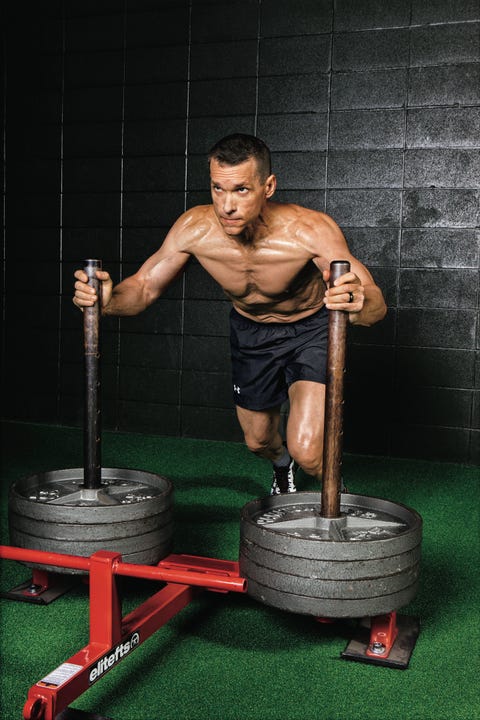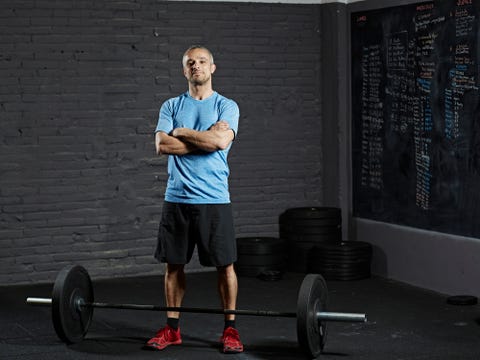This article originally ran in the October 2016 issue of Men’s Health.
Six months ago, Men’s Health fitness advisor Bill Hartman, P.T., was like many of us: in decent enough shape, but heading in the wrong direction after years of eating on the go while working long hours. Sure, he exercised hard a few days a week and ate healthy foods.“But I didn’t pay attention to portion sizes,” he says. A snack of a handful of cashews, for example, often became five or six handfuls, leaving him with a 600-calorie tab.
With the big 5-0 approaching, Hartman, a co-owner of IFAST Gym in Indianapolis, needed some inspiration. “Jack LaLanne would often do a big physical challenge on his birthday,” he says. “I thought maybe I should do something a little crazy too.” Hartman’s goal: to get shredded and regain the shape he was in back in his 20s, when he competed as a bodybuilder.
He would need to muster more effort this time, because losing fat and building muscle becomes harder with every passing year. After age 35, diminishing testosterone and slowing metabolism add to the challenge. Still, the path to a bodybuilder physique is the same: strict diet and exercise.
First, Hartman devised the perfect fitness plan. Next he recruited his friend, Men’s Health nutrition advisor Mike Roussell, Ph.D., to build him a nutrition program that would satisfy his appetite and sculpt his core.
“Then it all came down to following the plans,” says Hartman.
Now Hartman is down more than 25 pounds, and his body fat hovers around 7 percent. Losing fat and dropping pounds also benefited Hartman’s general health by reducing inflammation and improving his insulin levels, two factors that have health implications as we get older. “Smaller dogs live longer,” says Hartman, using an example from nature.
Want to get your bark back? Just follow the four fundamentals of Hartman’s program.
The 4 Steps to a 5-0 Shred

AssemblyGetty Images
Ease Into It
Many men think the only way to develop their abs is to hammer in the gym and slash their calorie intake. But if you do too much too soon, you could burn muscle and burn out mentally. Yes, big goals require big measures. “But if you go extreme right away and then stop progressing, where do you go from there?” Roussell asks. So start by cutting 200 to 300 calories a day from your diet. Stick to it. Once you reach that plateau (usually in two to four weeks), cut out another 200 to 300 and repeat. Hartman, for example, launched his plan by dropping to 2,200 daily calories; then he cut his intake further to 2,000 and ended at 1,750.
Be Flexible in the Gym
A typical training program prescribes a specific number of sets, such as 3 or 5. But because your performance can vary from day to day based on influences such as sleep and stress, that prescription might be too rigorous or too easy on any given day. That’s why Hartman based his training program around “autoregulation” sets. In those, your reps stay the same but the sets can vary depending on your performance. You do as many as you can until your form breaks down or your strength gives out. This strategy accomplishes two things: It hits your body with a stimulus that’s enough for you to make progress, and it keeps the brakes on to prevent you from digging too deep and sustaining an injury. To try it, check out the workout below.

Rudy Archuleta
Keep Having Fun
Every Saturday for the past decade, Hartman has taken his gym’s interns out for lunch at
a local Mexican cantina to talk shop, decompress, and review the week. “Obviously the fajitas, margaritas, and all the chips I could eat didn’t fly anymore,” says Hartman. So Roussell helped him find a meal he enjoyed that also worked for his diet. The solution? A spicy chicken breast on a bed of greens. “Maintaining normal rituals during your diet is key to sustainability,” says Roussell.
Plan Ahead
Midway through his transformation process, Hartman had to travel to China for 10 days.
He stuck to his nutrition plan by packing 24 Epic protein bars, 10 packages of Chef’s Cut Buffalo Style Real Chicken Jerky, and four cans of cashews. “When you’re committed to a goal, your nutrition decisions need to be made beforehand,” Roussell says. At home, Hartman tacked his eating plan on his fridge so he and his wife could easily shop and cook around it. “She also lost weight,” says Hartman.
BONUS TIP: Why Cardio Is Your Weight Loss Turbo
Going balls to the wall in the gym six days a week may actually sabotage your gains.Here’s why: Your body needs time between hard gym sessions to recover and build muscle. If you limit that time by doing tough workouts more than two days in a row, your muscle can’t rebuild. Instead, it just keep swearing down.
To make progress between his hard sessions, Hartman did relaxed cardio workouts. They helped increase blood flow to his muscles, boosting his recovery. Hit the stair climber or do a body-weight circuit of squats, step ups, inverted rows, and pushups. Keep at it for 45 to 60 minutes. Try to keep your heart rate between 120 and 150 beats per minute.
The Fast Track to a Six-Pack Workout

luza studiosGetty Images
Hartman designed this workout plan to help him to get ripped at—or even after—50.
In this program you’ll work out 5 days a week. On days 1, 3, and 5, you’ll lift. Here’s how: In the first exercise, you’ll “autoregulate” your sets. Afterward you’ll complete two different circuits.
On your strength training days (1, 3, and 5), start with the Primary Exercise. Each Primary Exercise is done using “autoregulation” sets; that is, you’ll do anywhere from 3 to 6 sets, depending on your form. If your form breaks down on, say, set 4, you’re done for that day. Some days you’ll be able to crank out 6 sets; others just 3. This method gives you a perfect muscle-building dose. Afterward, do the circuits: Perform the listed exercises in order and for the prescribed number of reps. The workout is over after you complete your circuits.
You can follow this program for anywhere from 4 to 12 weeks.
Day 1
PRIMARY EXERCISE 1
CIRCUIT 1
CIRCUIT 2
Day 2
CARDIO
Day 3
PRIMARY EXERCISE 5
CIRCUIT 3
CIRCUIT 4
Day 4
CARDIO
Day 5
PRIMARY EXERCISE 9
CIRCUIT 5
CIRCUIT 6

Morsa ImagesGetty Images
1. Barbell Floor Press
- Lie on your back and hold a barbell above your chest with your arms straight and knees bent. Lower the barbell until your upper arms touch the floor. Pause and press the weight back up to the starting position. If you don’t want to lie on the floor, do a regular bench press.
2. Dumbbell Alternating Low-Incline Bench Press
- Lie face up on an incline bench set to a low angle. Hold a pair of dumbbells above your chest with your arms straight and palms facing forward. Slowly lower your right arm to the side of your chest while keeping your left arm extended above your body. Press back up with your right arm, lower your left arm, and return to the starting position. That’s 1 rep.
3. Dumbbell Straight-Leg Deadlift
- Hold a pair of dumbbells at arm’s length in front of your thighs. Without rounding your lower back, bend at your hips and lower your torso toward the floor. Pause and return to the starting position.
4. Lat Pulldown
- Attach a lat pulldown handle to the high pulley of a cable station. Grab
the handle and sit in front of the weight stack. Slowly pull the handle to your chest. Pause and slowly reverse the move.
5. Chinup
- Hang at arm’s length from a chinup bar using an underhand, shoulder-width grip. This is the starting position. Pull your chest to the bar as fast as you can, pause, and take 2 seconds to lower yourself to the starting position.
6. Suitcase Carry
- Grab a heavy dumbbell, hold it at your side, and walk. Keep your torso straight throughout. Walk 100 feet; then switch sides and walk the 100 feet back.
7. Dumbbell Front Squat
- Hold a pair of dumbbells with your palms facing inward, upper arms perpendicular to the floor. Push your hips back and lower your body into a squat; then push back up.
8. Standing Single-Arm Kettlebell Push
- Stand holding a kettlebell in your right hand with your arm bent, the kettlebell just outside your right shoulder. Extend your left hand out to the side. Press the weight overhead until your arm is straight; then lower it to the starting position. (You can use a dumbbell instead of a kettlebell.) Do all your reps; then switch hands and repeat. Don’t rest between sides.
9. Deadlift
- Bend at your hips and knees and grab a barbell using an overhand grip, your arms just outside your legs. Now stand up, pulling the bar off the floor and thrusting your hips forward. Lower it back to the floor.
10. Single-Arm Dumbbell Row
- Hold a dumbbell in your left hand and place your right hand and right knee on a flat bench. Lower your torso until it’s almost parallel to the floor. Let the dumbbell hang at arm’s length from your shoulder. Pull the dumbbell to the side of your chest. Pause and return to the start. Do all your reps, switch sides, and repeat.
11. High-Knee Stepup
- Grab a pair of dumbbells and place your left foot on a bench or step. Press through your left heel and slowly lift yourself onto the bench as you raise your right knee to a 90-degree angle. Take 2 seconds to lower your right foot back to the floor. Do all your reps, switch legs, and repeat.
12. Kettlebell Pullover
- Lie on your back, holding a kettlebell by its horns above your chest with your arms straight.Bring your hips and knees to 90 degrees and feet together. Take in a big breath. As you breathe out, slowly lower the kettlebell directly behind your head, keeping your lower back on the floor. Pause; then breathe in as you pull it back up.
Source: Read Full Article
